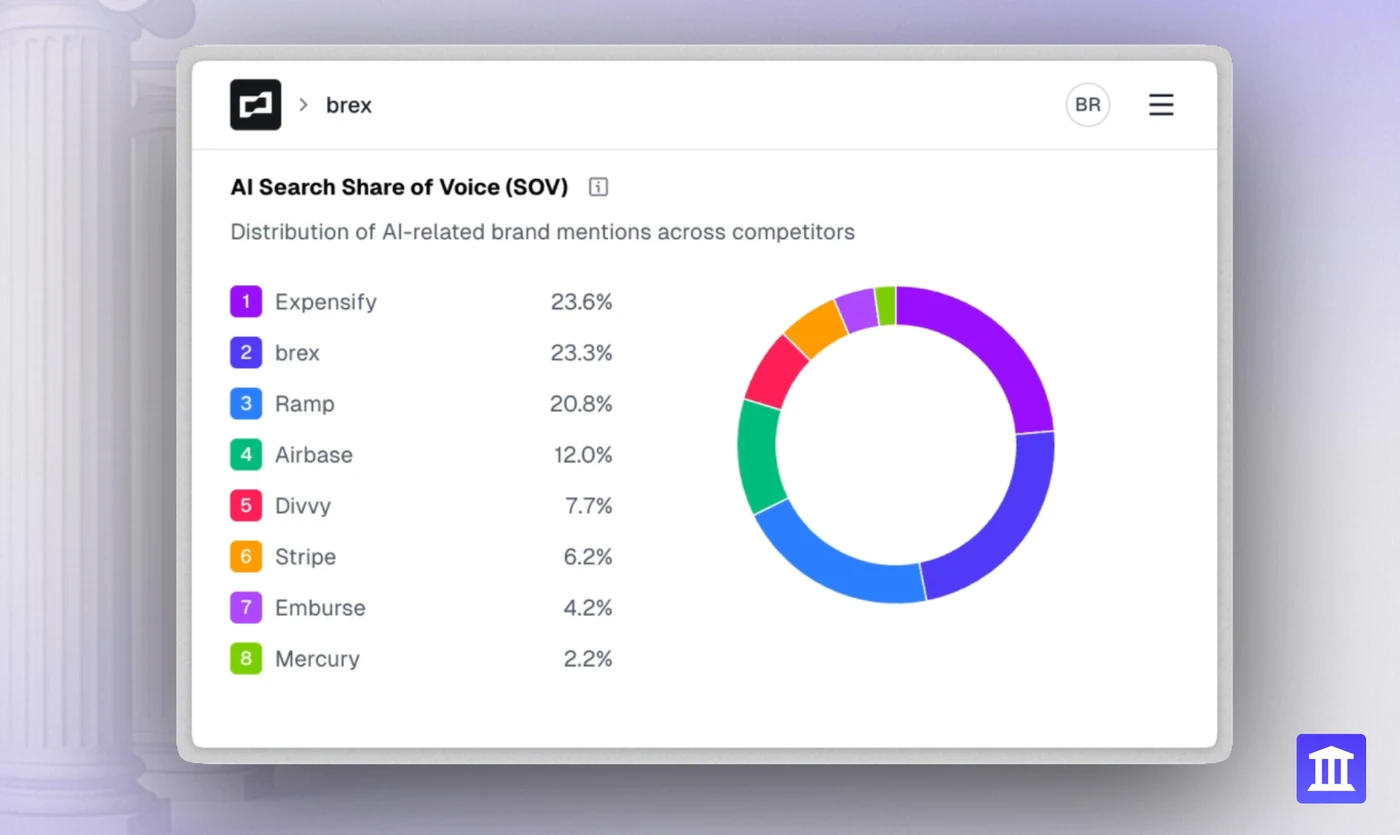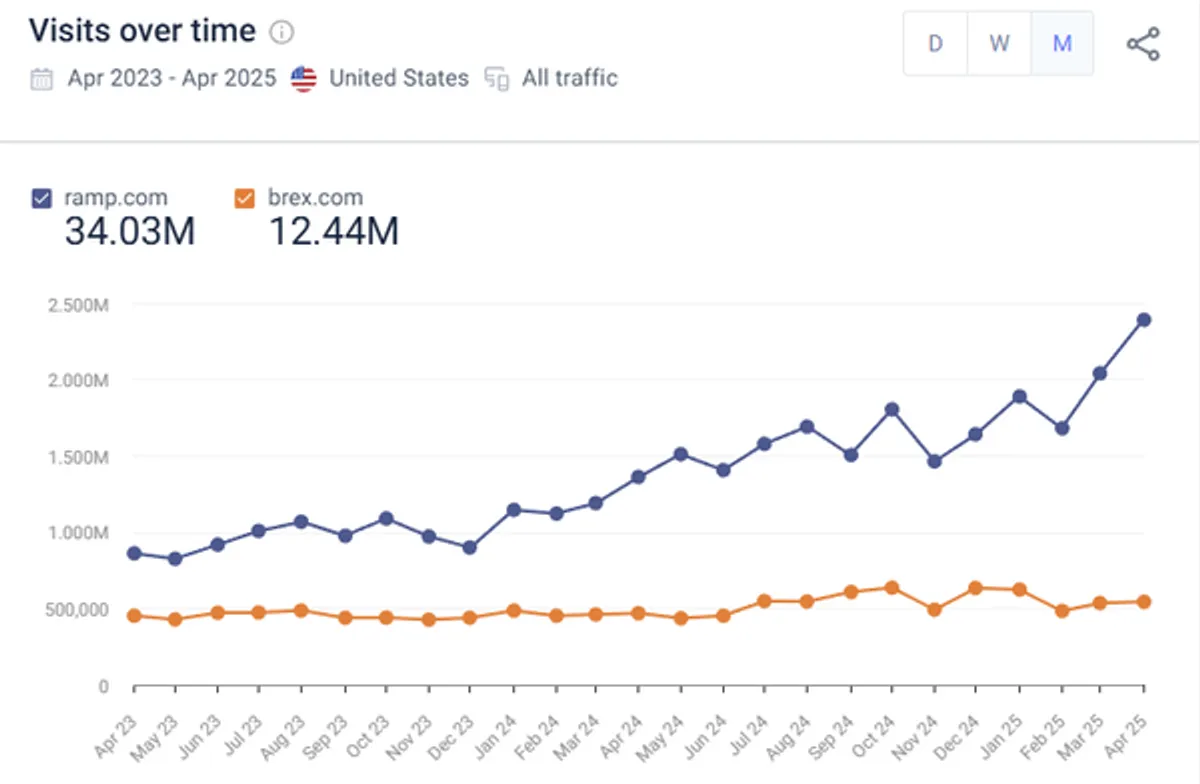
Brex vs Ramp: Differences Between Traffic Data from Similarweb & Reliable Share of Voice in AI Search
Both platforms promise to make expense management less painful, but when it comes to measuring their online impact, things get complicated—especially in the age of AI search.

Traditional web analytics tools like Similarweb offer one view, like the one discussed in this X post but if you want to know how your brand is performing in AI‐driven search results, you need a different approach. Let’s break down the real differences and why it matters for your business.
Why Expense Management Platforms Care About Visibility
The Stakes for Brex and Ramp
Brex and Ramp are more than just corporate cards. They’re comprehensive financial platforms that help businesses control spending, automate workflows, and keep finance teams sane[1][2]. But in a crowded market, visibility is everything. If your brand isn’t showing up where decision-makers are searching—especially in AI-powered platforms like ChatGPT—you’re missing out on leads, conversions, and, yes, those sweet, sweet OKRs.
The New Search Reality
Traditional SEO is no longer enough. AI search engines and generative platforms are changing how people discover and evaluate tools. If you’re not optimizing for these new channels, you’re invisible to a growing segment of your audience.
Example: A CFO asks ChatGPT, “What’s the best expense management tool for SaaS startups?” If your brand isn’t mentioned, you’re out of the running before the race even starts.
Comparing Traffic Data: Similarweb vs. Share of Voice in AI Search
How Similarweb Measures Up
Similarweb is a go-to for many marketers. It tracks website visits, user engagement, and referral sources. You get a sense of how much traffic Brex or Ramp is getting, where it’s coming from, and how users interact with their sites.
What Similarweb Tells You:
- Total website visits
- Traffic sources (organic, paid, referral, etc.)
- User engagement metrics (bounce rate, time on site)
What It Misses:
- Brand mentions in AI-generated answers
- Visibility in ChatGPT, AI Overviews, Gemini, Perplexity or other LLM-powered platforms
- Influence on decision-making in AI-driven search journeys
The Rise of Share of Voice in AI Search
Share of voice in AI search is a different beast. It measures how often your brand is mentioned or recommended in AI-generated responses, not just how many people visit your website. This is where AthenaHQ’s expertise comes in: we track and optimize your brand’s presence in generative AI results, not just traditional search engines.
What Share of Voice in AI Search Tells You:
- Frequency of brand mentions in AI-generated answers
- Sentiment and context of those mentions
- Competitive positioning in AI-driven recommendations
Why It Matters:
- AI platforms are becoming the first stop for business research
- Users trust AI-generated recommendations, often more than ads or organic search results
- Brands with higher share of voice in AI search see increased lead generation and conversion rates
Table: Comparing Similarweb Traffic Data vs. AI Search Share of Voice
| Criteria | Similarweb Traffic Data | Share of Voice in AI Search |
|---|---|---|
| Measures | Website visits, engagement | Brand mentions in AI answers |
| Platform Focus | Web browsers, traditional SEO | ChatGPT, AI Overviews, Perplexity, LLMs, AI platforms |
| Actionable Insights | Optimize web traffic | Optimize for AI-generated results |
| Impact on AI Discovery | Indirect | Direct |
| Relevance for GEO/AIO | Low | High |
Why Traditional Traffic Data Isn’t Enough for AI SEO
The Blind Spot in Web Analytics
If you’re only looking at Similarweb or Google Analytics, you’re missing a huge part of the picture. AI search engines don’t just pull from your website—they synthesize information from across the web, including reviews, news, and even competitor content. Your website traffic could be booming, but if AI platforms aren’t mentioning you, your brand is invisible where it counts.
Key Blind Spots:
- No insight into how often AI platforms recommend your brand
- No data on context or sentiment of AI mentions
- No way to track or improve AI-driven brand awareness without specialized tools
The AthenaHQ Approach: GEO and AIO for AI Search
At AthenaHQ, we specialize in Generative Engine Optimization (GEO) and AI Optimization (AIO). Our platform helps you:
- Track your brand’s share of voice in AI-generated search results
- Identify gaps where competitors are winning AI mentions
- Optimize your content and technical setup (like llms.txt) to boost your presence in AI answers
Technical Note: Configuring your llms.txt file correctly can influence how LLMs interpret and surface your content. AthenaHQ provides best practices and actionable insights for this critical step.
How Brex and Ramp Stack Up: Features, Pricing, and User Experience
Feature Comparison
Both Brex and Ramp offer robust expense management, but their approaches differ[1][3][2]:
- Brex: Focuses on proactive spend control, AI-powered budgets, and global business banking. Integrates with 1,000+ apps. Best for startups and fast-growing companies.
- Ramp: Emphasizes automation, accounting integrations, and comprehensive financial tools. Known for ease of use and strong customer satisfaction. Best for growing businesses needing advanced reporting.
Pricing Snapshot
| Plan Type | Brex (per user/month) | Ramp (per user/month) |
|---|---|---|
| Free/Essential | $0 | $0 |
| Standard/Premium | $12 | $15 |
| Enterprise | Custom | Custom |
Both offer free plans with limited features, making them accessible for small teams. Brex’s paid plans are generally more cost-effective for startups, while Ramp’s broader feature set appeals to larger organizations.
User Experience
- Brex: Praised for intuitive interface and efficient customer service. Some users report slower reimbursements.
- Ramp: High marks for automation and accounting features. Occasional learning curve for new users.
The Real Metric: Getting Noticed in AI Search
Why Share of Voice in AI Search Wins
If you want to win in 2025, you need to be where your buyers are searching. That means optimizing not just for web traffic, but for AI-driven recommendations. Share of voice in AI search is the new battleground for brand visibility.
Three Steps to Boost Your AI Share of Voice:
- Audit your current AI search presence (AthenaHQ can help)
- Optimize your content for LLMs using semantic analysis and llms.txt configuration
- Track and improve your AI brand mention OKRs with actionable insights
Insight: Brands that actively manage their AI share of voice see up to 2x higher conversion rates from AI-driven leads compared to those relying solely on traditional SEO metrics.
Key Takeaways for Expense Management Brands
- Website traffic is only part of the story. AI search visibility is now critical for lead generation and brand awareness.
- Similarweb data helps you understand web performance, but not your presence in AI-generated answers.
- Share of voice in AI search is the metric that matters for 2025 and beyond.
- AthenaHQ provides the tools and expertise to help you optimize for both traditional and AI-driven search engines.
“If you’re not showing up in AI search, you’re not showing up at all.”
Ready to Get Noticed by AI?
If you want your brand to be the answer—not just another search result—start tracking your share of voice in AI search today. AthenaHQ’s GEO and AIO platform gives you the insights and tools you need to win the next generation of search. Don’t let your competitors own the conversation. Make your brand the one AI recommends.
Curious how your brand stacks up in AI search? Reach out to AthenaHQ for a free audit and see where you stand.
Citations
[1] https://www.brex.com/versus/ramp
[2] https://www.capterra.com/compare/182054-207081/Brex-vs-Ramp